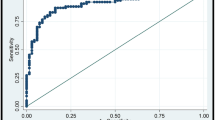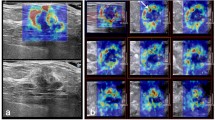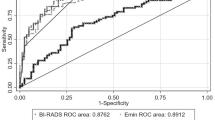Abstract
Purpose
This study was undertaken to evaluate the value of quantitative elastography in the diagnosis of breast tumours.
Materials and methods
Conventional ultrasound (US) and quantitative elastography were performed in 108 women with 114 breast lesions by two experienced radiologists, and pathological results were available in all cases. For each lesion, the maximum, mean, and minimum (min) elasticity and elasticity ratio between lesions and surrounding tissue were measured. The Breast Imaging Reporting and Data System (BI-RADS) categories were assessed with conventional US in all lesions.
Results
Malignant lesions exhibited significantly higher maximum and mean elasticity (111.57±69.29 kPa and 54.49±33.70 kPa) than did benign lesions (59.00±45.3 kPa and 36.64±26.18 kPa) (p<0.01). For maximum elasticity versus BI-RADS, performance results were sensitivity 60.9 % vs. 78.3%, specificity 85.3% vs. 98.5%, positive predictive value (PPV) 73.7% vs. 97.3 %, negative predictive value (NPV) 76.3% vs. 87.0 % and accuracy 75.4% vs. 90.3%. BI-RADS had significantly better accuracy than maximum elasticity (p<0.01). Maximum and mean elasticity of invasive ductal carcinoma (IDC) were significantly higher than those of fibroadenoma (p<0.01), whereas the difference was not statistically significant with fibroadenosis, papilloma and inflammation (p>0.01). Maximum and mean elasticity and elasticity ratio of BI-RADS 5 were all significantly higher than those of BI-RADS 3 (p<0.01). Reliability for maximum and mean elasticity were almost perfect [intraclass correlation coefficients (ICC)=0.87 and 0.79].
Conclusions
Shear-wave elastography gives quantitative elasticity information that could potentially help in breast-lesion characterisation, although it cannot replace conventional BI-RADS in the differentiation of breast lesions.
Riassunto
Obiettivo
Valutare l’utilità dell’elastografia quantitativa nella diagnosi del tumore alla mammella.
Materiali e metodi
108 donne con lesioni alla mammella sono state sottoposte ad ecografia convenzionale ed a studio elastografico quantitativo mediante supersonic shear imaging da due radiologi esperti; in ogni caso era disponibile il riscontro anatomopatologico delle lesioni. Per ogni lesione sono state misurate l’elasticità massima, media e minima, ed il rapporto di elasticità tra le lesioni ed il tessuto circostante. In tutti i casi sono state stimate le categorie BI-RADS (the Breast Imaging Reporting and Data System) mediante ecografia convenzionale. Risultati. Le lesioni maligne manifestavano elasticità massima e media significativamente maggiore (111,57±69,29 kPa e 54,49 ± 33,70 kPa) rispetto alle lesioni benigne (59,00±45,35 kPa e 36,64±26,18 kPa) (p<0,01). L’elasticità massima, nei confronti delle categorie BI-RADS, presentava sensibilità del 60,9 % vs. 78,3%, specificità del 85,3% vs. 98,5%, valore predittivo positivo (VPP) 73,7% vs. 97,3 %, valore predittivo negativo (VPN) 76,3% vs. 87,0 % ed accuratezza 75,4% vs. 90,3%. Le categorie BI-RADS presentano un’accuratezza significativamente migliore dell’elasticità massima (p<0,01). L’elasticità media e massima del carcinoma duttale invasivo (CDI) è risultata significativamente maggiore rispetto al fibroadenoma (p<0,01), mentre non sono emerse differenze statisticamente significative con la fibroadenosi, il papilloma e l’infiammazione (p>0,01). Le lesioni con BI-RADS 5 presentavano tutte un’elasticità media e massima significativamente maggiore rispetto alle lesioni con BI-RADS 3 (p<0,01). L’affidabilità dell’elasticità massima e media è risultata essere pressochè perfetta [coefficiente di correlazione intraclasse (CCI)=0,87 e 0,79].
Conclusioni
L’elastografia quantitativa mediante supersonic shear imaging fornisce informazioni che potrebbero essere potenzialmente utili nella caratterizzazione delle lesioni alla mammella, sebbene non possa sostituire il sistema BI-RADS convenzionale nella loro differenziazione.
Similar content being viewed by others
References/Bibliografia
Lerner RM, Huang SR, Parker KJ (1990) “Sonoelasticity” images derived from ultrasound signals in mechanically vibrated tissues. Ultrasound Med Biol 16:231–239
Krouskop TA, Wheeler TM, Kallel F et al (1998) Elastic moduli of breast and prostate tissues under compression. Ultrasonic Imaging 20:260–274
Thomas A, Degenhardt F, Farrokh A et al (2010) Significant differentiation of focal breast lesions: calculation of strain ratio in breast sonoelastography. Acad Radiol 17:558–563
Xing P, Wu L, Zhang C et al (2011) Differentiation of benign from malignant thyroid lesions: calculation of the strain ratio on thyroid sonoelastography. J Ultrasound Med 30:663–669
Niitsu M, Michizaki A, Endo A et al (2011) Muscle hardness measurement by using ultrasound elastography: a feasibility study. Acta Radiol 52:99–105
Dudea SM, Giurgiu CR, Dumitriu D et al (2011) Value of ultrasound elastography in the diagnosis and management of prostate carcinoma. Med Ultrason 13:45–53
Regini E, Bagnera S, Tota D et al (2010) Role of sonoelastography in characterising breast nodules. Preliminary experience with 120 lesions. Radiol Med 115:551–562
Kapoor A, Kapoor A, Mahajan G et al (2011) Real-time elastography in differentiating metastatic from nonmetastatic liver nodules. Ultrasound Med Biol 37:207–213
Itoh, Ueno E, Tohno E et al (2006) Breast disease: clinical application of US elastography for diagnosis. Radiology 239:341–350
Luo BM, Ou B, Feng X et al (2005) Breast diseases: comparative study of real-time tissue elastography with pathology. Chinese J Ultrasoun Med 21:662–664
Kumm TR, Szabunio MM (2010) Elastography for the characterization of breast lesions: initial clinical experience. Cancer control 17:156–161
Tanter M, Bercoff J, Athanasiou A et al (2008) Quantitative assessment of breast lesion viscoelasticity: initial clinical results using supersonic shear imaging. Ultrasound Med Biol 34:1373–1386
Athanasiou A, Tardivon A, Tanter M et al (2010) Breast lesions: quantitative elastography with supersonic shear imaging — preliminary results. Radiology 256:297–303
Evans A, Whelehan P, Thomson K et al (2010) Quantitative shear wave ultrasound elastography: initial experience in solid breast masses. Breast Cancer Res 12:R104
American College of Radiology (2003) ACR BI-RADS: ultrasound. In: ACR Breast Imaging Reporting and Data System Breast Imaging Atlas. Reston, VA: American College of Radiology
Giuseppetti GM, Martegani A, Di Cioccio B et al (2005) Elastosonography in the diagnosis of the nodular breast lesions: preliminary report. Radiol Med 110:69–76
Yamakawa M, Nitta N, Shiina T et al (2003) High-speed freehand tissue elasticity imaging for breast diagnosis. Jpn J App1 Phys 42:3265–3270
Fleury Ede F, Fleury JC, Piato S et al (2009) New elastographic classification of breast lesions during and after compression. Diagn Interv Radiol 15:96–103
Chang JM, Moon WK, Cho N et al (2011) Clinical application of shearwave elastography (SWE) in the diagnosis of benign and malignant breast diseases. Breast Cancer Res Treat 129:89–97
Cho N, Moon WK, Park JS et al (2008) Nonpalpable breast masses: evaluation by US elastography. Korean J Radio 9:111–118
Egorov V, Kearney T, Pollak SB et al (2009) Differentiation of benign and malignant breast lesions by mechanical imaging. Breast Cancer Res Treat 118:67–80
Chung SY, Moon WK, Choi JW et al (2010) Differentiation of benign from malignant nonpalpable breast masses: a comparison of computer-assisted quantification and visual assessment of lesion stiffness with the use of sonographic elastography. Acta Radiol 51:9–14
Author information
Authors and Affiliations
Corresponding author
Rights and permissions
About this article
Cite this article
Wang, Z.L., Li, J.L., Li, M. et al. Study of quantitative elastography with supersonic shear imaging in the diagnosis of breast tumours. Radiol med 118, 583–590 (2013). https://doi.org/10.1007/s11547-012-0903-x
Received:
Accepted:
Published:
Issue Date:
DOI: https://doi.org/10.1007/s11547-012-0903-x




